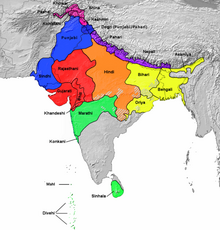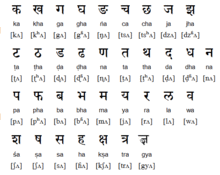Northern Indo-Aryan languages
This article needs additional citations for verification. (October 2011) |
| Pahari | |
|---|---|
| पहाड़ी | |
| (geographic) | |
| Geographic distribution | Nepal and north-western India |
| Linguistic classification | Indo-European |
| Subdivisions | |
| Glottolog | indo1310 |

The Pahari languages (Devanagari: पहाड़ी, pahāṛī 'of the mountains') are a geographic group of Indo-Aryan languages spoken in the lower ranges of the Himalayas, from Nepal in the east, through the Indian states of Uttarakhand,and Himachal Pradesh. Newari may also be called "Pahari/Pahri",[citation needed] but belongs to a different language family.
Classification
The Pahari languages fall into three genealogical groups. Eastern and Central Pahari have been placed together as the Northern zone of Indo-Aryan, with Western Pahari in the Northwestern zone along with Punjabi and related languages.
- Central Pahari
- Kumaoni is spoken by an estimated 2,360,000 people in Uttarakhand.[1]
- Garhwali is spoken by an estimated 2,900,000 people in Uttarakhand. Most of these are Garhwali people from the state's northwestern division of Garhwal.
- Eastern Pahari
- Jumli is spoken by an estimated 40,000 people in the Karnali zone of Nepal.[2]
- Nepali is spoken by an estimated 11,100,000 people in Nepal, 265,000 people in Bhutan, and 2,500,000 people in India. It is an official language in Nepal and India.[3]
- Palpa is spoken by an estimated 7,500 people in the Lumbini zone of Nepal.[4]
- Western Pahari
There are a dozen Western Pahari languages, of which Dogri and Kangri are the best known. Though traditionally considered Pahari, and often Hindi or Punjabi, the Western Pahari languages are more closely related to each other than to other Indo-Aryan languages. 17-20% of Jammu and Kashmir's population speaks Pahari languages. Pahari, along with Urdu, are the two most spoken languages in Azad Kashmir.
In Nepal

In Nepal, Nepali is the native language mainly of the Indo-Aryan Khas population of the "hills" north of the Mahabharat Range up to the limits of rice cultivation at about 2,500 meters. English speakers generally call it Nepali. Khaskura is also called Gorkhali or Gurkhali, the language of the Gurkhas, and Parbatiya, the language of the mountains. Palpa, closely related to Khaskura, is deemed by some authorities to be a separate language.[citation needed]
| Language | Group | Comment |
|---|---|---|
| Nepali | Eastern Pahari | Nepali is a lingua franca of Nepal, the Indian state of Sikkim and the Gorkhaland region of West Bengal. It is also widely spoken in Northeast region of India and also in Uttarakhand and Uttar Pradesh. |
| Kumaoni or Kumauni | Central Pahari | spoken in Kumaon region of Uttarakhand and Mahakali Zone of Nepal |
| Garhwali | Central Pahari | spoken in the Garhwal region of Uttarakhand |
| Himachali | Western Pahari | Kangri is spoken in the Kangra, Chamba, Bilaspur, Una, Mandi, Hamirpur districts of Himachal Pradesh and the Gurdaspur, Hoshiarpur districts of Punjab |
| Dogri | Western Pahari | Dogri has official status in Jammu and Kashmir |
History
The term Khaskura, "Khas talk," originated in western Nepal where it referred to the tongue of "Khas" Indo-Aryan rice growers mainly living along streams that enabled irrigation.
Perhaps five hundred years ago, Khas pioneers migrated eastward. They detoured around Kham uplands where rice could hardly be grown to settle in the lowlands of the Gandaki basin. One particular Khas family settled in the small Gorkha principality and ruled it for generations. This family was destined to become the Shah family that unified Nepal as we know it today, thus Khaskura came to be called Gorkhali.[citation needed]
Prithvi Narayan Shah conquered the urbanised Kathmandu Valley, then called Nepal, just east of the Gandaki basin. Nepal became Prithvi Narayan's new capital while he and his heirs went on to conquer small principalities for hundreds of miles along the Himalayas. Nepal gradually came to refer to the Shahs' entire realm, not just the Kathmandu Valley. Khaskura/Gorkhali became the new country's lingua franca, thus it came to be called Nepali as well.[citation needed]
Although the language of the Khasas has disappeared, the tribe is still numerically the most important Aryan one in this part of the Himalaya, and it hence gave its name to its newly adopted speech, which is at the present day locally known as "Khas-kura." In the manner described above the Aryan language of the whole Pahari area is now a form of Rajasthani, exhibiting at the same time traces of the old Khasa / Khas language which it superseded, and also in Nepal of the Tibeto-Burman forms of speech by which it is surrounded.[citation needed] (For information regarding Rajasthani the reader is referred to the articles Indo-Aryan Languages; Prakrit)
| Khas-kura | Kumauni | Kashmiri | ||||
|---|---|---|---|---|---|---|
| Masc | Fem | Masc | Fem | Masc | Fem | |
| I am | chu | chu | chik | chu | chus | ches |
| You are | chas | ches | chai | chi | chukh | chekh |
| He is | cha | che | ch | chi | chuh | cheh |
In Eastern and Central Pahari the verb substantive is formed from the root ach, as in both Rajasthani and Kashmiri. In Rajasthani its present tense, being derived from the Sanskrit present rcchami, I go, does not change for gender. But in Pahari and Kashmiri it must be derived from the rare Sanskrit particle *rcchitas, gone, for in these languages it is a participial tense and does change according to the gender of the subject. Thus, in the singular we have: – Here we have a relic of the old Khasa language, which, as has been said, seems to have been related to Kashmiri. Other relics of Khasa, again agreeing with north-western India, are the tendency to shorten long vowels, the practice of epenthesis, or the modification of a vowel by the one which follows in the next syllable, and the frequent occurrence of disaspiration. Thus, Khas siknu, Kumauni sikno, but Hindi sikhna, to learn; Kumauni yeso, plural yasa, of this kind.
Materials regarding Western Pahari are not so complete. The speakers are not brought into contact with Tibeto-Burman languages, and hence we find no trace of these. But the signs of the influence of north-western languages are, as might be expected, still more apparent than farther east. In some dialects epenthesis is in full swing, as in (Churahi) khata, eating, fern, khaiti. Very interesting is the mixed origin of the postpositions defining the various cases. Thus, while that of the genitive is generally the Rajasthani ro, that of the dative continually points to the west. Sometimes it is the Sindhi khë. At other times it is jo, where is here a locative of the base of the Sindhi genitive postposition jo. In all Indo-Aryan languages, the dative postposition is by origin the locative of some genitive one. In vocabulary, Western Pahari often employs, for the more common ideas, words which can most readily be connected with the north-western and Piedca groups.[citation needed] (See Indo-Aryan Languages.)
Mountainous dialects
- Khas-Kura, as its speakers themselves call it, passes under various names. The number of speakers in British India 143,721 were recorded in the census of 1901, most of whom were soldiers in, or others connected with, the British Gurkha regiments. At present Khas kura or Nepali is the lingua franca of Nepal spoken by millions.[citation needed]
- Central Pahari, includes three dialects – Garhwali, spoken mainly in Garhwal and the country round the hill station of Mussoorie; Jaunsari, spoken in the Jaunsar-Bawar tract of Dehradun; and Kumaoni, spoken in Kumaon, including the country round the hill station of Nainital. In 1901 the number of speakers was 1,270,931.[citation needed]
- Western Pahari, includes a great number of dialects. In the Simla Hill states alone no less than twenty-two, of which the most important are Sirmauri and Keonthali (the dialect of Simla itself), were recorded at the last census. To these may be added Chambiali and Churahi of the state of Chamba, Mandyali of the state of Mandi, Himachali of Chamba and Kangra, Kuluhi of Kulu and others. In 1901 the total number of speakers was 1,710,029.[citation needed]
Western Pahari (Himachali) dialects include: Kangri, Kullu, Mandeali, etc. The Central Pahari dialects spoken in Uttarakhand include Garhwali, Kumaoni and others. Garhwali itself has many subdialects spoken in different parts of the state, like Jaunsari, Jadhi, etc. In Uttarakhand the language is referred to colloquially as mwari twari (mine and yours).[citation needed]
About
The Himalayas run along Nepal, India and Pakistan. The word 'Pahar' means a 'mountain' in most local languages such as Nepalese, Hindi (Parbat being a synonym) as well as Urdu (Koh being a synonym). Due to its mass prevalence and usage in the Himalayan Region, the language is also known as Himalayan. Like all other languages of the region, the Pahari languages are also from the Indo-European, and in particular Indo-Iranian branch of languages. As mountains have the tendency of isolating communities from change, dialects in the mountains tend to have their own characteristics with some similarity to others mountain dialects while remaining isolated from one another – there does seem to be a dialect continuum. All of these dialects are commonly referred to as the 'Pahari' languages, and most people from the Himalayan range as known as Paharis.
See also
References
- This article incorporates text from a publication now in the public domain: Chisholm, Hugh, ed. (1911). "Pahari". Encyclopædia Britannica (11th ed.). Cambridge University Press.
- ^ "Kumaoni". Ethnologue: Languages of the World. SIL International. Retrieved 23 December 2012.
- ^ "Jumli". Ethnologue: Languages of the World. SIL International. Retrieved 23 December 2012.
- ^ "Nepali". Ethnologue: Languages of the World. SIL International. Retrieved 23 December 2012.
- ^ "Palpa". Ethnologue: Languages of the World. SIL International. Retrieved 23 December 2012.
